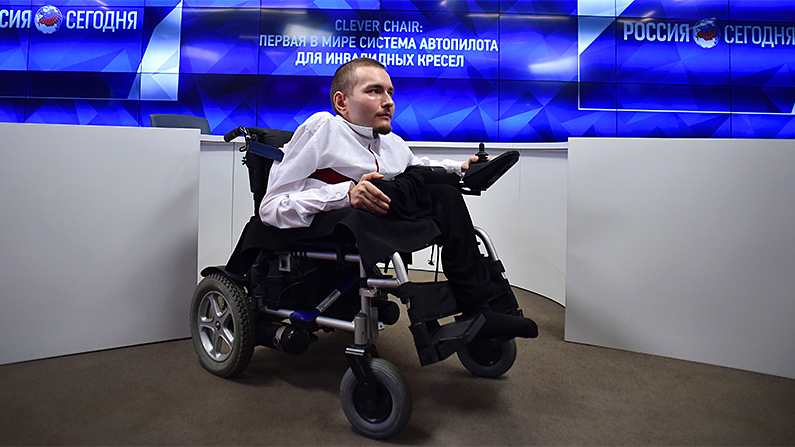The man who volunteered to be the first to have his entire head transplanted to a new body never got the surgery—but he has a new and improved life nonetheless.
Valery Spiridonov has suffered all his life from Werdnig-Hoffmann disease, which causes his muscles to atrophy. He cannot stand up, let alone walk. He has spent most of his life trapped in a wheelchair.
Spiridonov, now 33, heard about the groundbreaking research of Italian neurosurgeon Dr. Sergio Canavero in 2015.
Canavero published a paper in 2013 describing the procedure for a complete head transplant—attaching a healthy head to a donor body. He published his updated plans in June 2015, and Spiridonov immediately volunteered.
“I can hardly control my body now,” Spiridonov told Medical News Today in 2015. “I need help every day, every minute. I am now 30 years old, although people rarely live to more than 20 with this disease.”
In his 2015 paper, Canavero estimated that it would take a team of 100 surgeons 36 hours to complete the operation.
Most of the medical community was skeptical. Even Canavero had to admit that while reconnecting the veins and arteries would be easy—though complicated—connecting the two spinal cords (spinal cord fusion, or SCF) would be exceedingly difficult.
In the 2015 paper, Canavero said, “The key to SCF is a sharp severance of the cords themselves, with its attendant minimal damage to both the axons in the white matter and the neurons in the gray laminae. This is a key point.”
Spiridonov learned that the earliest possible date for the surgery would be two years off, at least. However, Canavero told Newsweek that he was confident that there would be a 90 percent chance of success.
Head Transplant Research Moves to China
In fact, the possibility of success was soon revealed to be zero.
Almost exactly two years after Canavero published his second paper, Spiridonov admitted publicly that the surgery was not going to happen, the Daily Mail reported. In June 2017, Spiridonov said that Canavero had decided to perform the surgery in China instead.
It is possible the doctor changed his plans to take advantage of China’s looser medical ethics laws and to avoid legal complications if the surgery failed.
WACTH ME LIVE ON FACEBOOK: FRIDAY, NOVEMBER 17, 10.30 a.m. CET (on this account). At my International Press Conference…
In November 2017, Canavero announced that he had successfully transplanted the head of one cadaver to another. Working with a team led by Dr. Xiaoping Ren of Harbin Medical University, China, Canavero grafted the head of one corpse onto the body of another—a procedure that took 18 hours, according to the Telegraph.
Canavero and Xiaoping had previously teamed up to transplant the head of one monkey to another, the Telegraph reported. The monkey never regained consciousness and if it had, would have been paralyzed—the surgeons did not attempt to fuse the two spinal cords.
The next step will be a head swap between two brain-dead organ donors, Canavero told the Sun. After that, he would begin working with a Chinese donor with a disease or disability such as Spiridonov had.
With Canavero committed to working with the Chinese team—and receiving funding from Chinese sources, the Sun reported—Valery Spiridonov’s opportunity for a new body has passed.
Despite losing his chance at a healthy body, the Russian-born computer scientist is undismayed.
“I feel a weight lifted off my chest,” Spiridonov told the Daily Mail. I never had a vain motive to become the first (head transplant). I gave two years of my life to this project. I will be glad to see it happening (with someone else).”
Living a Good Life Despite His Disease
Valery Spridinonov did not spend those two years daily.
While waiting on word from Canavero, the computer wizard designed a “smart” wheelchair, which responds to voice commands—perfect for his needs.
Spiridinov moved the Florida where he enrolled in the University of Florida to study computer analysis of emotions, the Sun reported. He supports himself with consulting jobs.
The most important changes in his life are not technical nor medical—they are romantic.
Spridonov got married to fellow scholar Anastasia Panfilova at a ceremony in Moscow about a year ago. She moved to the United States to be with him and recently gave birth to the couple’s first child—a son.
“We lived in the same city, and often met in professional settings, and soon realized that we felt really good together,” Spiridonov explained to the Daily Mail.
“She has several degrees. We got married a little over one year ago in Moscow.”
Werdnig-Hoffmann disease can be passed down to offspring. Soon after they realized Panfilova was pregnant, the couple got her tested—and the results showed that the child did not inherit the damaged gene that causes the disease.
Spiridonov considers that a “miracle.”
The brave new father does not regret not getting a healthy body.
“I am deeply grateful to Canavero,” Spiridonov told the Sun. “Thanks to our joint efforts, a lot is changing for the better, and for me too.”


